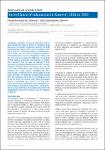Surveillance of tularaemia in Kosovo*, 2001 to 2010
Grunow, Roland
Kalaveshi, A.
Kühn, Andrea
Mulliqi-Osmani, G.
Ramadani, N.
Tularaemia, caused by Francisella tularensis, had not been registered in Kosovo* before an outbreak in 1999 and 2000. A national surveillance system has been implemented in Kosovo* since 2000 to monitor a number of diseases, including tularaemia. Antibody detection in human sera was used for laboratory diagnosis of tularaemia and F. tularensis lipopolysaccharide antigen was used as a marker of infection. The purpose of this study is to describe the incidence of tularaemia in Kosovo* after the 1999–00 outbreak. In 2001 and 2002, a second outbreak occurred, with 327 serologically confirmed cases. From 2001 to 2010, 25–327 cases were registered per year, giving a mean annual incidence of 5.2 per 100,000 population. The most likely sources of infection were contaminated drinking water and food. The dominant clinical manifestations were the glandular (79%) and ulcero-glandular (21%) forms. By 2010, the disease had spread throughout Kosovo*. Presumably as a result of war and subsequent environmental disruption, mass population displacement and breakdown of sanitation and hygiene, the two major outbreaks of tularaemia resulted in the establishment of an active endemic area of tularaemia in Kosovo*.
Dateien zu dieser Publikation
Keine Lizenzangabe

